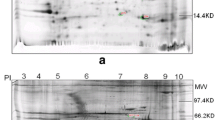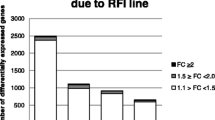Abstract
Nutritional selenium deficiency is associated with Keshan disease in humans and white muscle disease in ruminant livestock. In this study, mice were fed a selenium-deficient diet for three generations. Female mice from the third depleted generation of these mice were given water containing either no added selenium or 0.1 or 1.0 ppm selenium as sodium selenate; DNA microarrays were used to compare gene expression in the muscle from mice fed the selenium diets to that from mice remaining on the depleted diet. The most prominent expression increases were observed with Ptger2 (a prostaglandin E receptor), Tcrb-V13 (a T-cell receptor beta), Tcf-7 (a T-cell transcription factor), and Lck (lymphocyte protein tyrosine kinase), and the major consistent decrease was Vav2, an oncogene in mice consuming the selenium containing diets.
Similar content being viewed by others
References
G. F. Combs, Jr., L. C. Clark, and B. W. Turnbull, An analysis of cancer prevention by selenium, Biofactors 14, 153–159 (2001).
U. Schweizer, L. Schomburg, and N. E. Savaskan, The neurobiology of selenium: lessons from transgenic mice, J. Nutr. 134, 707–710 (2004).
F. J. Martin-Romero, G. V. Kryukov, A. V. Lobanov, et al., Selenium metabolism in Drosophila: selenoproteins, selenoprotein mRNA expression, fertility, and mortality, J. Biol. Chem. 276, 29,798–29,804 (2001).
J. R. Arthur, R. C. McKenzie, and G. J. Beckett, Selenium in the immune system, J. Nutr. 133, 1457S-1459S (2003).
P. Chariot and O. Bignani, Skeletal muscle disorders associated with selenium deficiency in humans, Muscle Nerve 27, 662–668 (2003).
K. M. Brown and J. R. Arthur, Selenium, selenoproteins and human health: a review. Public Health Nutr. 4, 593–599 (2001).
J. R. Schubert, O. H. Muth, J. E. Oldfield, and L. F. Remmert, Experimental results with selenium in white muscle disease of lambs and calves. Fed. Proc. 20, 689–694 (1961).
Y. Li, T. Peng, Y. Yang, C. Niu, L.C. Archard, and H. Zhang, High prevalence of enteroviral genomic sequences in myocardium from cases of endemic cardiomyopathy (Keshan disease) in China, Heart 83, 696–701 (2000).
S. D. Cho, C. Jiang, B. Malewicz, et al., Methyl selenium metabolites decrease prostate-specific antigen expression by inducing protein degradation and suppressing androgen-stimulated transcription, Mol. Cancer Ther. 3, 605–611 (2004).
R. Brigelius-Flohe, A. Banning, M. Kny, and G. F. Bol, Redox events in interleukin-1 signaling Arch. Biochem. Biophys. 423, 66–73 (2004).
R. Xia, H. E. Ganther, A. Egge, and J. J. Abramson, Selenium compounds modulate the calcium release channel/ryanodine receptor of rabbit skeletal muscle by oxidizing functional thiols, Biochem. Pharmacol. 67, 2071–2079 (2004).
M. W. Brown and J. H. Watkinson, An automated fluorometric method for the determination of nanogram quantities of selenium, Anal. Chim. Acta 89, 29–35 (1977).
M. A. Beilstein and P. D. Whanger, Deposition of dietary organic and inorganic selenium in rat erythrocyte proteins, J. Nutr. 116, 1701–1710 (1986).
M. Mahadevappa and J. A. Warrington, A high-density probe array sample preparation method using 10-to 100-fold fewer cells, Nat. Biotechnol. 17, 1134–1136 (1999).
G. V. Kryukov, S. Castellano, S. V. Novoselov, et al., Characterization of mammalian selenoproteomes, Science 300, 1439–1443 (2003).
R. C. McKenzie, J. R. Arthur, and G. J. Beckett, Selenium and the regulation of cell signaling, growth, and survival: molecular and mechanistic aspects, Antioxid. Redox Signal. 4, 339–351 (2002).
J. Bai, The combined effect of selenium deficiency and viral infection on the myocardium of mice (preliminary study) (author's transl). Zhongguo Yi Xue Ke Xue Yuan Zue Bao 2, 29–31 (1980) (in Chinese).
J. E. Oldfield, O. H. Muth, and J. R. Schubert, Selenium and vit. E as related to growth and white muscle disease in lambs, Proc. Soc. Exp. Biol. Med. 103, 799–800 (1960).
J. A. Noble, A. M. White, L. C. Lazzeroni, et al., A polymorphism in the TCF7 gene, C883A, is associated with type 1 diabetes, Diabetes 52, 1579–1582 (2003).
R. Ramoyska, A. Basson, A. Filby, G. Legname, M. Lovatt, and B. Seddon, The influence of the src-family kinases, Lck and Fyn, on T cell differentiation, survival and activation, Immunol. Rev. 191, 107–118 (2003).
D. Weichenhan, B. Kunze, S. Zacker, W. Traut, and H. Winking, Structure and e expression of the murine Sp100 nuclear dot gene, Genomics 43, 298–306 (1997).
J. W. Regan, EP2 and EP4 prostanoid receptor signaling, Life Sci 74, 143–153 (2003).
K. Fujikawa, A. V. Miletic, F. W. Alt, et al., Vav1/2/3-null mice define an essential role for Vav family proteins in lymphocyte development and activation but a differential requirement in MAPK signaling in T and B cells, J. Exp. Med. 198, 1595–1608 (2003).
H. Nakamura, T. Kato, T. Yamamura, et al., Characterization of T cell receptor beta chains of accumulating T cells in chronic ongoing myocarditis demonstrated by heterotopic cardiac transplantation in mice, Jpn. Circ. J. 65, 106–110 (2001).
K. K. Hirschi and M. W. Majesky, Smooth muscle stem cells, Anat. Rec. 276A, 22–33 (2004).
T. N. Dear and T. Boehm, Diverse mRNA expression patterns of the mouse calpain genes Capn5, Capn6 and Capn11 during development, Mech. Dev. 89, 201–209 (1999).
L. Rao, B. Puschner, and T. A. Prolla, Gene expression profiling of low selenium status in the mouse intestine: transcriptional activation of genes linked to DNA damage, cell cycle control and oxidative stress, J. Nutr. 131, 3175–3181 (2001).
M. A. Beck, Selenium and host defence towards viruses, Proc. Nutr. Soc. 58, 707–711 (1999).
J. E. Spallholz, L. M. Boylan, and H. S. Larsen, Advances in understanding selenium's role in the immune system. Ann. N. Y. Acad. Sci. 587, 123–139 (1990).
Author information
Authors and Affiliations
Rights and permissions
About this article
Cite this article
Hooven, L.A., Butler, J., Ream, L.W. et al. Microarray analysis of selenium-depleted and selenium-supplemented mice. Biol Trace Elem Res 109, 173–179 (2006). https://doi.org/10.1385/BTER:109:2:173
Received:
Revised:
Accepted:
Issue Date:
DOI: https://doi.org/10.1385/BTER:109:2:173




